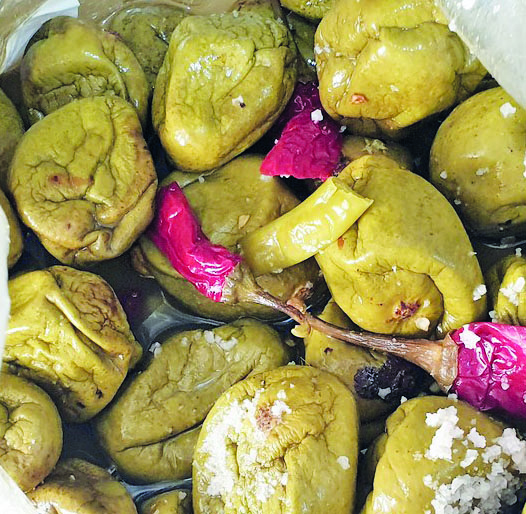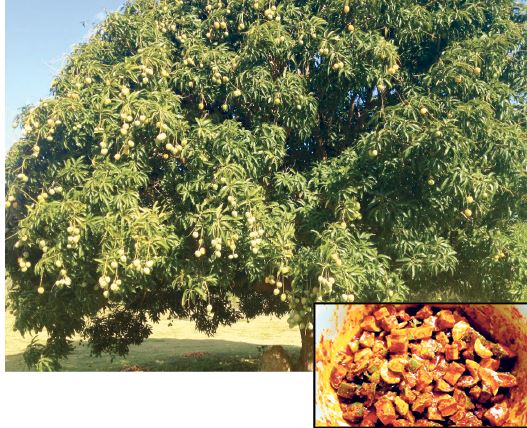There is a heat wave on and the mango trees are blooming over and fruiting prematurely….Goa is a mango state and this is torache season (inset) Goan’s favorite fresh green mango pickle is miskut! Make it yourself or buy it from the Panaji market women vendors
By Tara Narayan
Eating is Fun / Eating is Yuck! – A variety food column
IT’S green mango season in Goa even if it has started earlier this year — because of all the unnatural heat in the air (a fallout of all the bombing in Ukraine affecting the earth’s temperature, Russia’s President Vladimir Putin needs to be educated and hauled on the subject of waging war and the fallout for the rest of the world). Seriously, I can’t tell whether it’s springtime or summertime currently in the springtime Vasant Panchami going into Holi season of March-April. Season of romance if you know your Lord Shiva-Goddessed Parvati mythology folk stories.
Currently it’s like steaming full blown summer-time in capital city Panaji and Goa in general, see how the African tulips, copperpods, rain trees, and the other day I say a gulmohur breaking into bloom in March (when it is the final tree to bloom when summer comes to a close). Okay, forget that for the moment.
Suddenly the mango trees in town have come alive baby green mangoes are festooned here and there and I can’t take my eyes of them! Will go for a toss on my navy blue angel bike one of these days…anyway, one may see the toran (baby mangoes in Konkani) here, there and everywhere. See them tucked in foliage cosily or dangling down and somewhere a branch of mango flower cluster ready to sprout soon into teeny weeny mango babes…the first sight of “tora” or “toram” (m is silent) on trees always makes my mouth water! Though of coursed green mangoes have to grow a little fatter before they acquire they acquire their tart sweet temptations to various degree depending on the variety and whether wild or domesticated cultivars.
In Goa they say it is toranchye season and there’re piles of green mangoes of various sizes at the Panaji market, also in the early morning pavement market, my friend here Jonquita quoted Rs50 for 20 little green mangoes last week for making the green mango favourite fresh pickle of miskut…but then further down the Taleigao roads there’s ready-made miskut to buy in little plastic babs (Rs50 per 100 g or so and if it’s fresh the masala spiced mango pickle will still retain its green mango crunch. Suman who sits beneath an apte tree at the turn of the broad Babush Monserrate road tells me she doesn’t make it over salty or over red chilli hot or over oiled but just perfect, so I end up buying her expensive miskut in plastic pouches if 100 g or so for Rs50. Must tell her to make me a special order and give her my own bottle. On a good day I can make a meal of just phulka and miskut except that I have to go off eating wheat products completely one of these days! It is too salty, too oily, too sugary, too refined, overcooked…which sets us up for diabetes and heart disease, you must know that by now if knowing means anything at all in our rat-race lives of plenty but little discipline and no goals to work towards with any passion.
TOO go on early mornings or nights one may see children after the green mangoes dangling on mango trees in town…throwing assorted stout sticks up to bring stray fruit down for them to grab, rub off any fluff and dip into pinch of salt-chili powder to relish. Such joy on their faces! I feel like parking nearby and just watching them and occasionally demanding, “Give me one green mango!” They give me two! Nothing like green mango to quench thirst and titillate the palate.
These days of course most Goans are buying green toran by the hundred pieces to turn them into water pickle mangoes (fermented in brine) – Goa’s famous chepnim mangoes. Wipe the mangoes, put them in a ceramic bowl (although plastic pails, bottles, bowls are much loved, don’t please) and scatter rough sea salt between layers of green mango, Goan Hindu housewives will also scatter dry red chillies and pinches of Shankar Chap asafoetida (hing), cover with linen or jute cloth and press down with some large good stones. Turn mangoes over in a day or two.
Store in cool darkness till the mangoes turn crunchy soft and may be sliced to serve as appetizers with evening cocktail snacks and a drink or two…fresh juice of coconut trees called toddy or caju neero or urrack or feni on the rocks, etc. I always say mango chepnim can take the place of olives any time in Goa and India, I prefer sliced chepnim but the green mangoes for making chepnim must be the right variety or you may end up with a fibrous squashy mass of loose mangoes. Use clean dry hands or spoon to remove the water pickled mangoes in lots as required or you know what will happen if not squeaky clean – watch out for fungofying mangoes.
Yes, I like to stuff chepnim slices with cheddar in my sourdough bread sandwiches and enjoy whenever I can! Chepnim may come over salted too of course and then you’ll be pining for water to drink in gallons. So enjoy but don’t overdo it.
OKAY, I found a recipe in one of my cookbooks which I haven’t given away yet! Here it is:

